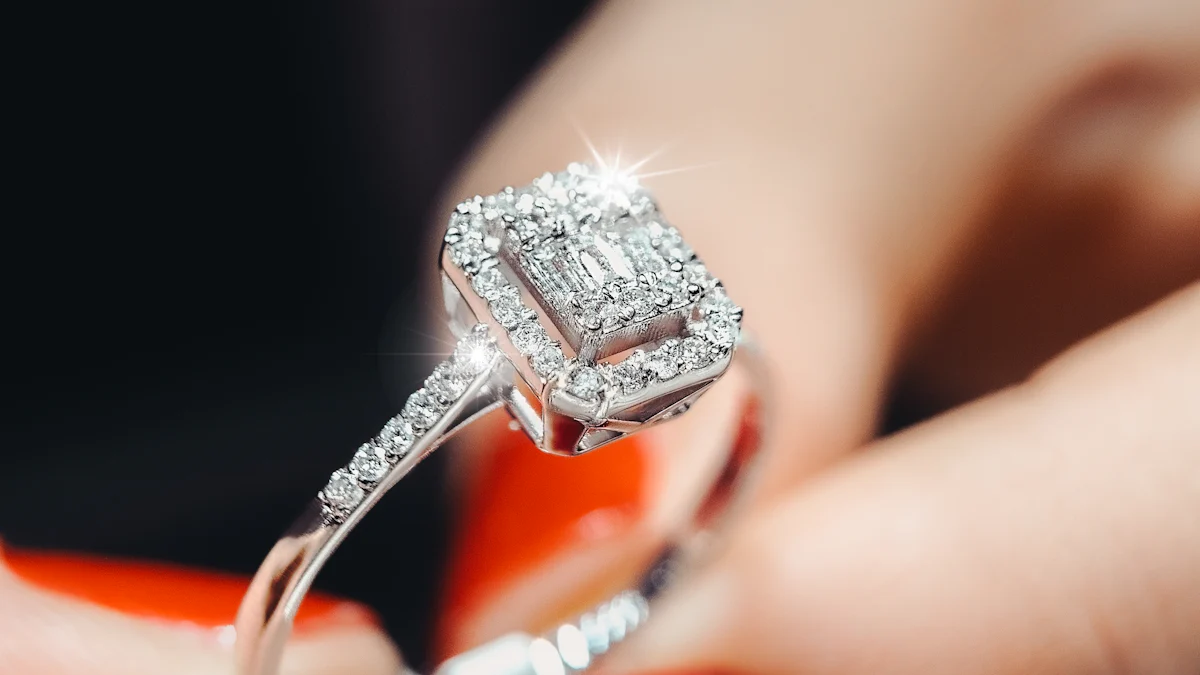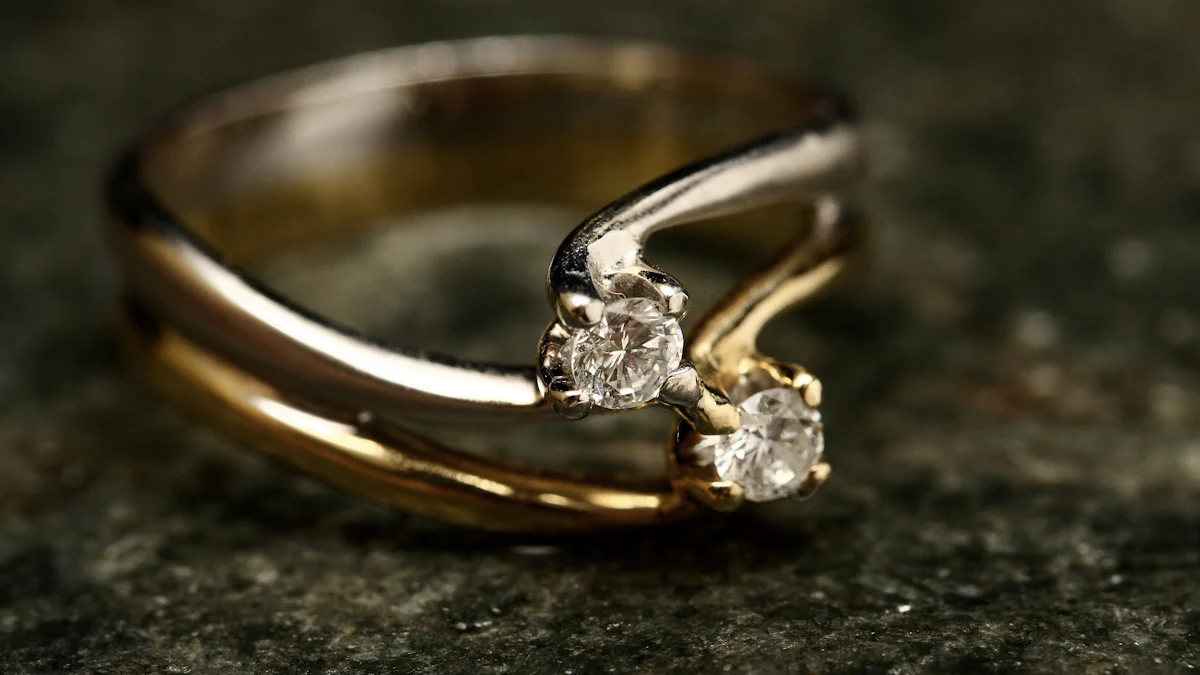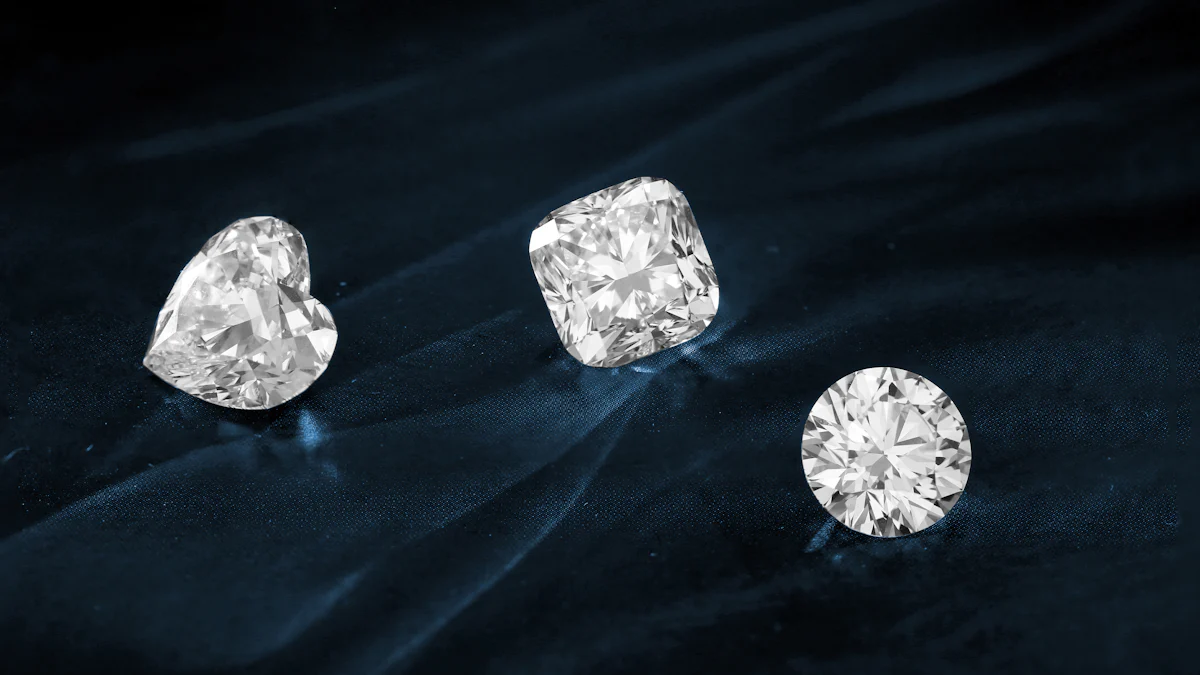VS vs VVS Diamond Meaning Explained

When you explore the world of diamonds, understanding the difference between VS and VVS diamond clarity becomes crucial. These terms define the visibility of inclusions within a diamond, impacting both its beauty and value. The vs diamond meaning refers to "Very Slightly Included," indicating that these diamonds have small inclusions that are hard to detect even under magnification. On the other hand, VVS diamonds, or "Very Very Slightly Included," boast even fewer inclusions, making them appear almost flawless. Recognizing these differences helps you make informed decisions, ensuring you choose a diamond that aligns with your preferences and budget.
Understanding Diamond Clarity
When you delve into the world of diamonds, understanding diamond clarity becomes essential. Clarity refers to the presence of internal or external imperfections, known as inclusions and blemishes, respectively. These imperfections can affect a diamond's appearance and value. To evaluate diamonds, experts use the clarity grading scale, which ranges from Flawless to Included.
The 4Cs of Diamonds
The 4Cs—Carat, Cut, Color, and Clarity—serve as the foundation for assessing a diamond's quality.
Carat
Carat measures a diamond's weight. Larger diamonds typically have higher carat weights, making them more valuable. However, carat alone doesn't determine a diamond's worth; other factors like cut and clarity also play crucial roles.
Cut
Cut refers to how well a diamond's facets interact with light. A well-cut diamond reflects light beautifully, enhancing its brilliance and sparkle. The cut significantly influences a diamond's overall appearance and value.
Color
Color evaluates the absence of color in a diamond. The scale ranges from D (colorless) to Z (light yellow or brown). Colorless diamonds are rare and highly prized, while those with noticeable color may be less valuable.
Clarity
Clarity assesses the presence of inclusions and blemishes. Diamonds with fewer imperfections receive higher clarity grades. The vs diamond meaning and vvs diamonds fall under this category, with vs diamonds having slight inclusions and vvs diamonds having very, very slight inclusions.
Clarity Grading Scale
The clarity grading scale categorizes diamonds based on their inclusions and blemishes.
Explanation of the Scale from Flawless to Included
- Flawless (FL): No internal or external imperfections visible under 10x magnification.
- Internally Flawless (IF): No internal imperfections visible under 10x magnification, though minor external blemishes may exist.
- Very, Very Slightly Included (VVS1 and VVS2): Minute inclusions that are extremely difficult to detect even under 10x magnification.
- Very Slightly Included (VS1 and VS2): Inclusions noticeable under 10x magnification but generally not visible to the naked eye.
- Slightly Included (SI1 and SI2): Inclusions noticeable under 10x magnification and may be visible to the naked eye.
- Included (I1, I2, and I3): Inclusions obvious under 10x magnification, potentially affecting the diamond's durability and appearance.
Understanding these grades helps you make informed decisions when purchasing diamonds. Whether you choose a vs diamond or a vvs, knowing the clarity grade ensures you select a diamond that meets your expectations and budget.
What is a VS Diamond?
When you consider purchasing a diamond, understanding the vs diamond meaning becomes essential. VS diamonds, short for "Very Slightly Included," possess inclusions that are visible under 10x magnification. However, these inclusions are generally not noticeable to the naked eye. This makes VS diamonds an attractive choice for those seeking a balance between quality and affordability.
Definition and Characteristics
VS diamonds fall into two categories: VS1 and VS2. Both grades indicate that the diamond has minor inclusions, but they differ slightly in terms of visibility. VS1 diamonds have fewer and less visible inclusions compared to VS2 diamonds. Despite these differences, both types maintain a high level of brilliance and beauty. The inclusions in VS diamonds do not significantly impact their overall visual appeal, allowing them to appear nearly flawless to most viewers.
Common Inclusions in VS Diamonds
Inclusions in VS diamonds can vary in size, location, and number. Common types include small crystals, feathers, or clouds. These imperfections are often located away from the center of the diamond, minimizing their impact on the stone's appearance. The clarity scale considers these factors when assigning a clarity grade. While VS diamonds may have more inclusions than VVS diamonds, they still offer an eye-clean appearance, making them a popular choice for many buyers.
What is a VVS Diamond?
When you explore the realm of high-clarity diamonds, understanding the vvs diamond becomes essential. VVS diamonds, or "Very Very Slightly Included" diamonds, rank among the highest on the clarity scale. These diamonds possess inclusions so minute that they are nearly impossible to detect without magnification. To the naked eye, vvs diamonds appear virtually flawless, offering exceptional sparkle and beauty.
Definition and Characteristics
VVS diamonds are divided into two categories: vvs1 and vvs2. Both grades indicate a high level of clarity, but they differ slightly in terms of inclusion visibility. VVS1 diamonds have inclusions so tiny that even under 10x magnification, they remain challenging to spot. This makes them appear eye-clean, with no visible blemishes to the naked eye. On the other hand, vvs2 diamonds may have slightly more noticeable inclusions under magnification, yet they still maintain an impressive level of clarity. The vvs2 vs vvs1 comparison highlights the subtle differences in inclusion size and visibility, but both types offer remarkable brilliance and appeal.
Common Inclusions in VVS Diamonds
Inclusions in vvs diamonds are typically extremely small, often appearing as pinpoints. These tiny imperfections rarely affect the diamond's overall appearance or brilliance. Unlike vs diamonds, which may have more noticeable inclusions, vvs diamonds maintain a pristine look. The clarity grade of vvs diamonds ensures that these inclusions do not detract from their beauty, making them a preferred choice for those seeking high-clarity diamonds. When you choose a vvs diamond, you invest in a stone that combines rarity with exceptional visual appeal.
Visual Differences

Can You See the Difference?
When you examine VS diamonds and VVS diamonds, you might wonder if you can spot the differences with the naked eye. Both types of diamonds often appear eye-clean, meaning their inclusions are not visible without magnification. However, VVS diamonds have fewer and less noticeable inclusions compared to VS diamonds. This subtle difference in diamond clarity can affect the overall appearance and value of the diamond. While VS diamonds offer a balance of quality and affordability, VVS diamonds provide a higher level of clarity, making them more desirable for those seeking near-flawless stones.
Importance of Magnification
Magnification plays a crucial role in distinguishing between VS and VVS diamonds. Under 10x magnification, you can observe the inclusions that define the vs diamond meaning. VS diamonds may show small inclusions that are difficult to detect, while VVS diamonds exhibit inclusions that are nearly impossible to see even under magnification. This microscopic examination highlights the superior clarity of VVS diamonds, which contributes to their higher value and rarity. Understanding these differences helps you make informed decisions when selecting a diamond that aligns with your preferences and budget.
Price Differences

When you consider purchasing a diamond, understanding the price differences between VS diamonds and VVS diamonds becomes essential. These differences arise from various factors, including clarity, rarity, and overall quality.
Cost Implications of VS vs VVS
-
Clarity and Rarity: The primary reason VVS diamonds command higher prices is their superior clarity. With fewer inclusions, these diamonds appear nearly flawless, making them more desirable. Their rarity further elevates their value, as fewer VVS diamonds are available in the market compared to VS diamonds.
-
Quality and Investment: Investing in VVS diamonds often means paying a premium for their exceptional quality. These diamonds not only offer stunning visual appeal but also hold their value well over time. On the other hand, VS diamonds provide a more affordable option while still maintaining excellent clarity and beauty. They strike a balance between quality and cost, making them a popular choice for many buyers.
-
Market Demand: The demand for VVS diamonds often exceeds that for VS diamonds, contributing to their higher prices. Collectors and investors frequently seek VVS diamonds for their rarity and investment potential, driving up their market value.
Factors Influencing Price
-
Cut Quality: The cut of a diamond significantly impacts its price. A well-cut diamond enhances light performance, increasing its brilliance and sparkle. This factor is crucial for both VS and VVS diamonds, but it can particularly affect the price of VVS diamonds due to their higher clarity.
-
Size and Carat Weight: Larger diamonds with higher carat weights generally cost more. However, when comparing diamonds of similar size, VVS diamonds will typically be more expensive than VS diamonds due to their superior clarity.
-
Certification and Grading: Certified diamonds with documented clarity grades often fetch higher prices. When purchasing a diamond, ensure it comes with a reputable certification that verifies its clarity and quality.
Understanding these price differences and factors helps you make informed decisions when selecting a diamond. Whether you choose a VS diamond for its affordability or a VVS diamond for its exceptional clarity, knowing these details ensures you find a diamond that aligns with your preferences and budget.
Buying Considerations
When you're ready to purchase a diamond, several factors should guide your decision. Understanding these considerations ensures you select a diamond that aligns with your needs and expectations.
Certification and Authenticity
Certification plays a crucial role in verifying a diamond's authenticity and quality. Reputable gemological laboratories, such as the Gemological Institute of America (GIA), provide certificates that detail a diamond's characteristics, including its clarity. These documents confirm the diamond's value and authenticity, offering peace of mind in your purchase. Always request a certificate when buying a diamond to ensure you receive a genuine product.
Personal Preferences and Use
Your personal preferences significantly influence your choice between VS diamonds and VVS diamonds. Consider how you plan to use the diamond. If you desire a stone for everyday wear, a VS diamond might offer the perfect balance of beauty and affordability. However, if you seek a diamond for special occasions or as an investment, a VVS diamond, with its superior clarity, might be more appealing. Reflect on your style and the diamond's intended purpose to make an informed decision.
Resale Value and Investment
The resale value of a diamond depends on several factors, including its clarity. VVS diamonds often hold their value better due to their rarity and high clarity. They can serve as a sound investment, potentially appreciating over time. Conversely, VS diamonds, while still valuable, may not command the same resale price as VVS diamonds. Consider your long-term goals when purchasing a diamond. If investment potential is a priority, a VVS diamond might be the better choice.
Understanding the key differences between VS and VVS diamond clarity is crucial for making informed decisions. VS diamonds, with their slight inclusions, offer a balance of quality and affordability. In contrast, VVS diamonds, with very few inclusions, provide exceptional clarity and rarity. When choosing between them, consider your personal needs and budget. Each diamond should be reviewed individually to identify imperfections. If you're unsure, consult experts for guidance. Remember, the highest clarity grades may not always be necessary for an eye-clean diamond, allowing you to optimize your budget effectively.
FAQ
What is the difference between a VVS and VS clarity diamond?
The primary difference lies in the visibility of inclusions. VVS diamonds, or "Very Very Slightly Included," have inclusions that are extremely difficult to detect even under 10x magnification. They are divided into two categories: VVS1 and VVS2, with VVS1 having fewer inclusions. VS diamonds, or "Very Slightly Included," have inclusions that are slightly more noticeable under magnification but still not visible to the naked eye.
What are VVS diamonds?
VVS diamonds possess fewer and less obvious inclusions compared to VS diamonds. The Gemological Institute of America (GIA) grades diamond clarity, and VVS diamonds rank high on this scale. They are known for their exceptional clarity and brilliance, making them a popular choice for those seeking near-flawless stones.
Is it worth buying VVS diamonds?
In many cases, paying extra for a VVS diamond may not be necessary. You can often find diamonds with lower clarity grades that appear identical to the naked eye. However, consider VVS diamonds for larger stones or specific shapes where inclusions might be more visible. Ultimately, your decision should align with your personal preferences and budget.
Can you see the inclusions in VS diamonds without magnification?
No, you typically cannot see the inclusions in VS diamonds without magnification. These diamonds have inclusions that are noticeable under 10x magnification but generally remain invisible to the naked eye. This makes them an attractive option for those seeking quality at a more accessible price.
How does diamond clarity affect the price?
Diamond clarity significantly impacts the price. VVS diamonds command higher prices due to their superior clarity and rarity. VS diamonds offer a balance of quality and affordability, making them a popular choice for many buyers. The fewer the inclusions, the higher the diamond's value.
Are VVS diamonds a good investment?
VVS diamonds can be a good investment due to their rarity and high clarity. They often hold their value well over time. If investment potential is a priority for you, consider VVS diamonds. However, always weigh this against your budget and personal preferences.
Do VVS diamonds have better resale value than VS diamonds?
Yes, VVS diamonds generally have better resale value than VS diamonds. Their rarity and exceptional clarity make them more desirable in the market. If you plan to resell your diamond in the future, a VVS diamond might offer a higher return.
Should I prioritize clarity over other diamond characteristics?
While clarity is important, you should consider all aspects of the 4Cs—Carat, Cut, Color, and Clarity—when choosing a diamond. Each factor contributes to the diamond's overall beauty and value. Balance your priorities based on what matters most to you.
How do I ensure the authenticity of a diamond's clarity grade?
Always request a certificate from a reputable gemological laboratory, such as the GIA. This document verifies the diamond's clarity and other characteristics, ensuring you receive a genuine product. Certification provides peace of mind and confirms the diamond's value.
Can I find eye-clean diamonds in lower clarity grades?
Yes, you can find eye-clean diamonds in lower clarity grades, such as VS or even SI. These diamonds may have inclusions, but they are not visible to the naked eye. Choosing an eye-clean diamond allows you to optimize your budget while still enjoying a beautiful stone.
See Also
Comparing Prices for All Around Diamond Rings
A Guide to Diamond Cuts for Engagement Rings
In-Depth Comparison of Tungsten and Traditional Diamond Rings

